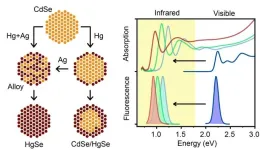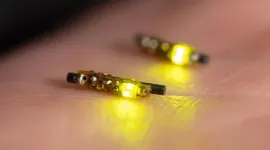(Press-News.org) Daily sugar intake fell by around 5 g in children and by around 11 g in adults in the 12 months following the introduction of the UK’s ‘sugar tax’, formally known as the Soft Drinks Industry Levy, finds an analysis of 11 years of survey data, published online in the Journal of Epidemiology & Community Health.
The sugar from soft drinks alone made up over half this total, the estimates suggest. But overall daily energy intake from free sugars levels are still higher than the updated recommendation from the World Health Organisation (WHO) of 5%---equivalent to 30 g/day for adults, 24 g for 7–10 year olds, and 19 g for 4–6 year olds—point out the researchers.
Mounting evidence implicates consumption of sugar sweetened drinks, which are a major source of dietary free sugars, particularly among children, in a heightened risk of weight gain, type 2 diabetes, coronary heart disease and premature death.
To date, more than 50 countries have introduced a sugar tax on soft drinks in a bid to persuade manufacturers to reformulate their products. The UK did so in 2018.
While the evidence suggests that sugar intake derived from these drinks fell in the year following its introduction, it’s not clear whether other sources of dietary sugar were substituted instead.
To assess the impact of the levy on total sugar intake, the researchers drew on 11 years of responses (2008–19) to the annual nationally representative UK National Diet and Nutrition Survey. This captures information on food consumption, nutrition, and nutrient intake in and outside of the home from 500 adults and 500 children over a 4-day period.
The researchers looked particularly at absolute and relative changes in total intake of dietary free sugars from all food and soft drinks combined and from soft drinks alone, to include full and low calorie soft drinks; semi-skimmed, whole and skimmed milk; fruit juice; and other milk drinks and cream.
Protein intake was used as a comparator because although not subject to a levy, it could still be affected by influential factors such as increases in food prices, say the researchers.
The results draw on information for 7999 adults and 7656 children, and estimated changes in free sugar consumption are based on the period January to March 2019 and compared with what would be expected had no sugar tax been announced and implemented.
In the period after the sugar tax was announced in 2016, free sugars consumed from all soft drinks more or less halved in children and fell by a third in adults compared with the period before the announcement.
Taking into consideration previous trends in free sugar consumption, the survey responses indicated that 1 year after the UK sugar tax had come into force children further reduced their free sugar intake from food and drink combined by around 5 g/day (relative reduction of 10%) and adults by around 11 g/day (relative reduction of 20%).
Over half of this total was from soft drinks alone, accounting for around 3 g/day (relative reduction of 23.5%) in children and around 5 g/ day (relative reduction of just under 40.5%) in adults. Protein intake remained stable throughout in children and adults.
“In children, a daily reduction of 4.8 g sugar equates to approximately 19.2 kilocalories out of an approximate daily intake of 2000 kilocalories which is equivalent to approximately 1% reduction in energy intake,” point out the researchers.
Energy intake from free sugars as a proportion of total energy consumed didn't change significantly following the the introduction of the levy, indicating energy intake from free sugar was reducing at the same time as overall total energy intake, and suggesting that people didn’t change their diets substantially by substituting more sugary foods and drinks, say the researchers.
It wasn’t possible to study different age groups due to the limited number of participants, but falls in the levels of sugar in food and drink may have affected different age groups differently, say the researchers.
For example, the largest single contributor to free sugars in 4–10 year olds is cereal and cereal products, followed by soft drinks and fruit juice. By the age of 11–18, soft drinks provide the largest single source (29%). For adults the largest source of free sugars is sugar, preserves, and confectionery, followed by non-alcoholic drinks, they explain.
The fall in consumption of free sugars observed in the whole diet rather than just from soft drinks suggests that consumption of free sugar from food was also falling from as early as 2008, they add. This might be because of the public health signalling following the announcement, they suggest.
END
Daily sugar intake fell by 5 g in kids + 11 g in adults year after UK sugar tax imposition
Sugar from soft drinks alone made up over half of this total, estimates suggest. But daily energy intake from free sugars still higher than 5% recommended by WHO
2024-07-10
ELSE PRESS RELEASES FROM THIS DATE:
Osteoarthritis may double risk of speedy progression to severe multimorbidity
2024-07-10
Osteoarthritis—a condition in which the protective cartilage on the ends of bones breaks down—may more than double the risk of speedy progression to accumulating severe long term conditions (multimorbidity), finds a 20 year study published in the open access journal RMD Open.
And there seem to be 4 different speeds of progression to multimorbidity, the findings indicate.
Persistently low levels of physical activity, a high calorie diet, plus chronic low grade inflammation may help to explain the link between osteoarthritis and the risk of accumulating other long term conditions, suggest the researchers.
Although the exact causes aren’t known, injury, age, family ...
Researchers listen to the hearts of bats in flight
2024-07-10
Researchers from Konstanz have measured the heart rate of bats over several days in the wild, including complete flights—the first time this has been done for a bat species. To record the heart rate of male common noctule bats during flight, the scientists attached heart rate transmitters weighing less than one gram to the animals, which they then accompanied in an airplane while the bats flew, sometimes for more than an hour, in search of food. Their results, published in Proceedings of the Royal Society B, show how much energy bats consume over the course of a day and what energy-saving strategies they ...
Familial endocrine diseases linked to increased risk of pregnancy loss, new research shows
2024-07-10
Women who have close family members with endocrine diseases, including type 2 diabetes, thyroid diseases and polycystic ovary syndrome (PCOS), are at higher risk of pregnancy loss, a new study has found [1].
The research, presented today at the ESHRE 40th Annual Meeting in Amsterdam, examined the association between various endocrine diseases and the incidence of pregnancy loss. The study investigated 366,539 women in Denmark between 1973 and 2022.
The study found that women with parents diagnosed with endocrine diseases faced a 6% higher risk of pregnancy loss ...
Health AI expert Nathan Price joins Buck faculty
2024-07-09
The Buck Institute for Research on Aging announces the appointment of Nathan Price, PhD, to Professor and Co-Director of the Center for Human Healthspan. Price specializes in systems biology, artificial intelligence, and bioengineering. He has published more than 200 scientific papers and is co-author, with Buck Chief Innovation Officer and Distinguished Professor Lee Hood, of “The Age of Scientific Wellness.” Price has been named one of 10 Emerging Leaders in Health and Medicine by the National Academy of Medicine and is a member of the Board on Life Sciences of the National Academies of Sciences, Engineering, and Medicine.
Dr. Price is Chief Scientific Officer ...
Greater focus needed on how existing international law can prevent the increasing militarisation of outer space
2024-07-09
There is a pressing need for countries and international organisations to understand better how existing international law can help them address serious concerns about the militarisation of outer space, a new study says.
Space ...
Found with Webb: a potentially habitable icy world
2024-07-09
A international team of astronomers led by Université de Montréal has made an exciting discovery about the temperate exoplanet LHS 1140 b: it could be a promising "super-Earth" covered in ice or water.
When the exoplanet LHS 1140 b was first discovered, astronomers speculated that it might be a mini-Neptune: an essentially gaseous planet, but very small in size compared to Neptune. But after analyzing data from the James Webb Space Telescope (JWST) collected in December 2023 - combined with previous data from other space telescopes such as Spitzer, Hubble and ...
New one-step method to make multiple edits to a cell’s genome
2024-07-09
SAN FRANCISCO, CA—Genome editing has become a widely adopted technology to modify DNA in cells, allowing scientists to study diseases in the lab and develop therapies that repair disease-causing mutations. However, with current approaches, it’s only possible to edit cells in one location at a time.
Now, a team of scientists at Gladstone Institutes has developed a new method that enables them to make precise edits in multiple locations within a cell—all at once. Using molecules called retrons, they created a tool that can efficiently modify DNA in bacteria, yeast, and human cells.
“We wanted to push the boundaries of genomic technologies ...
Moving from the visible to the infrared: Developing high quality nanocrystals
2024-07-09
Awarded the 2023 Nobel Prize in Chemistry, quantum dots have a wide variety of applications ranging from displays and LED lights to chemical reaction catalysis and bioimaging. These semiconductor nanocrystals are so small—on the order of nanometers—that their properties, such as color, are size dependent, and they start to exhibit quantum properties. This technology has been really well developed, but only in the visible spectrum, leaving untapped opportunities for technologies in both the ultraviolet and infrared regions of the electromagnetic ...
Implantable LED device uses light to treat deep-seated cancers
2024-07-09
Certain types of light have proven to be an effective, minimally invasive treatment for cancers located on or near the skin when combined with a light-activated drug. But deep-seated cancers, surrounded by tissue, blood and bone, have been beyond the reach of light’s therapeutic effects.
To bring light’s benefits to these harder-to-access cancers, engineers and scientists at the University of Notre Dame have devised a wireless LED device that can be implanted. This device, when combined with a light-sensitive ...
LA County faces dual challenge: Food insecurity and nutrition insecurity
2024-07-09
While food insecurity has long been the focus of local and national policymakers and researchers, nutrition insecurity has largely been overlooked. A new study by the Institute for Food System Equity (IFSE) at the USC Dornsife College of Letters, Arts and Sciences aims to change that.
This is the first study in Los Angeles County to identify the populations most affected by nutrition insecurity, distinct from food insecurity. Nutrition insecurity refers to a lack of access to healthy food that ...
LAST 30 PRESS RELEASES:
Pioneering natural, degradable polymer capsules
Forestry is becoming digital and automated
Maternity baby deaths much higher in northern England than in the South
Mosquitoes’ thirst for human blood has increased as biodiversity loss worsens
The stop-smoking medication varenicline may also work for cannabis use disorder
Potential new treatment for sepsis
Study reveals how many hours of video games per week might be too many
Electrospinning for mimicking bioelectric microenvironment in tissue regeneration
Home fingertip oxygen monitors less accurate for people with darker skin tones
Six weeks in a cast no less effective than surgery for unstable ankle fractures
Precautionary approach to alcohol-free and low alcohol drinks needed to protect public health, say experts
Gas-atomized Ca–Mg alloy powders produce hydrogen simply by adding water — high-efficiency hydrogen generation at room temperature
British redcoat’s lost memoir reveals harsh realities of life as a disabled veteran
World-leading rare earth magnet recycling facility launches in UK
Corday Selden selected for the Oceanography Society Early Career Award
MIT chemists determine the structure of the fuzzy coat that surrounds Tau proteins
Same moves, different terrain: How bacteria navigate complex environments without changing their playbook
Severe weather is deadly for vulnerable older adults long after the storm ends, study finds
Expert panel highlights opportunities for improving cancer studies
Hearing aid prescriptions not associated with changes in memory and thinking
Seth Zippel selected for The Oceanography Society Early Career Award
Jeremy Horowitz selected for The Oceanography Society Early Career Award
Kennesaw State University’s Jerry Mack named Paul “Bear” Bryant Newcomer Coach of the Year
Ancient teeth are treasure troves of data on Iron Age lifestyles
Avocados may become easier to grow in India—but not if global emissions remain high
Pregnant women with IBD show heightened inflammation in vaginal mucosa
Underwater photos show seabirds, seals and fish interacting with a tidal turbine in Washington State
1 in 5 surveyed UK adults who have experienced the death of a pet report it as more distressing than experienced human deaths, with significant rates of prolonged grief disorder symptoms also being re
Polyester microfibers in soil negatively impact the development of cherry tomato plants in experiments, raising concerns over the potential effect of high levels of such contaminants
LGBTQ+ adults may be around twice as likely to be unemployed or to report workforce non-participation compared to heterosexual adults, per large representative Australian survey
[Press-News.org] Daily sugar intake fell by 5 g in kids + 11 g in adults year after UK sugar tax impositionSugar from soft drinks alone made up over half of this total, estimates suggest. But daily energy intake from free sugars still higher than 5% recommended by WHO





